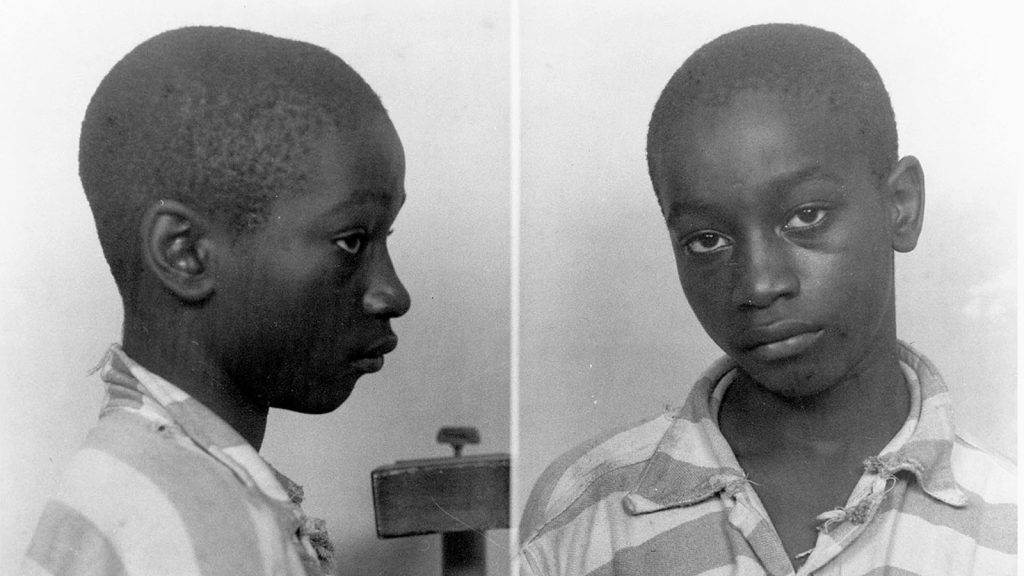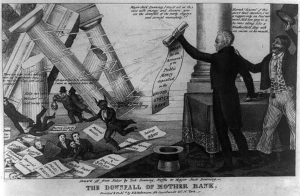
June 16, 1944 was execution day at the Central Correctional Institution in Columbia, and next on the docket to confront the electrical chair was George Stinney, a 14-year-old African American boy from Acolu, South Carolina. George weighed merely 95 pounds and stood at only 5” 1′ at the time he was strapped to an electric chair too big for his physique.1 Due to George’s small physique, extra holes needed to be punched into the chair’s leather bindings before the bindings could fit onto George’s limbs. This extra step bought George a couple extra minutes of life before he faced the electric chair.2 What was 14-year-old George Stinney thinking about right before execution? Surely not that he would soon become the youngest person executed in the 20th century.3

On March 24, 1944, tragedy and injustice came strolling into the small segregated lumber mill town of Alcolu, South Carolina. Betty June Binnicker, 11, and Mary Emma Thames, 7, were walking with their bike when they came across Aime Stinney Ruffner and George Stinney. The girls asked Aime and George whether or not they knew where they could find Maypops. Aime and George responded with a “no” and the girls went on their way. The night of March 24, Betty and Mary were reported missing after both girls failed to return home. The morning after, Betty June Binnicker and Mary Emma Thames were found dead in a ditch with their bikes laying on top of them. Police arrived at the Stinney household and arrested George, a 14-year-old African American boy, for the murders on Betty June Binnicker and Mary Emma Thames.4 Unfortunately, at the time police arrested George, the 1966 Supreme Court ruling on Miranda v. Arizona, which requires law enforcement officials to advise suspects of their rights, had not been ruled yet.5 After the police arrested and interrogated George without any access to his parents nor to an attorney, George confessed to the murders of Betty Binnicker and Mary Thame.6 George Stinney was not the only party impacted as a result of the murders, the Stinney family was persecuted by the rest of the town due the accusation against George. George Stinney Sr. was fired from work and the entire family was forced to permanently leave Acolu and move to Pinewood where the grandmother resided. Aime Stinney Ruffner stated, “We had no choice, the crowd came and they said they were going to get us.”7
The judge presiding over the case appointed Charles Plowden, 31-year-old local lawyer and aspiring politician, to represent George Stinney during the trial. On April 24, 1944, residents of Alcolu packed the local courthouse hoping justice would be served swiftly. A jury composed of 12 white men would be destined to determine George Stinney’s fate.8 Plowden failed to motion for a change of venue, which is a motion to change the location of a trial to overcome local prejudice. Stinney could have had a less partial jury in a different location. The prosecution’s case relied on the testimony of two police officers giving an account of Stinney’s confession he made during his interrogation. According to the police, Stinney confessed to having followed Betty Binnicker and Mary Thames after initially making contact with the girls, then unsuccessfully attempted to rape Betty, and then proceeded to beat both Betty and Mary with a railroad spike that had been laying around. The prosecution presented Stinney’s birth certificate as the last piece of evidence. The prosecution presented the birth certificate to make the case that Stinney was born on October 21, 1921, making him 14 years of age, which was traditionally the accepted age of criminal responsibility at the time.9 Plowden failed to cross-examine the prosecution’s witnesses, call forth any witness that could have corroborated with Stinney’s alibi, question the circumstances under which the police obtained the confession, nor to point out the lack of physical evidence, nor to point out the impracticality of a 14-year-old boy weighing 95 pounds and standing at 5 feet and 1 inch of physically being able to murder two girls, and finally failed to file an appeal. Plowden’s only defense comprised of the defendant being too young to be held responsible for the crimes he committed. Stinney’s trial, that would determine whether he lived or died, lasted a total of 3 hours. The judge sentenced the jury to deliberation, and 10 minutes later the jury comprised of 12 white men, found 14 year old George Stinney guilty of the murders of Betty June Binnicker and Mary Emma Thames. The judge sentenced George Stinney to death by electrocution. On June 16, 1944, the 2,400 volts of electricity passing through George Stinney rendered his body lifeless.10

70 years after the execution of George Stinney, Stinney’s three remaining siblings are seeking justice of their own with the help of a group of lawyers and civil rights advocates determined to exonerate Stinney. Stinney’s prosecution combined unconstitutional errors with serious misconduct. The team of attorneys argued in the Sumter County Courthouse that Stinney’s verdict was solely based on a coerced confession, therefore, the verdict should be thrown out.11 Due to new testimony, Stinney’s family, along with the team of attorneys, are hoping Judge Carmen T. Mullen, of the Fourteenth Circuit Court in South Carolina, rules in their favor. Despite most of the evidence, including Stinney’s confession and the transcript of the trial disappeared, Mullen heard new testimony from Stinney’s brothers and sisters, a witness from the search party, a child forensic psychiatrist, and a statement from Wilford Hunter, Stinney’s former cellmate.12 Frankie Bailey Dyches, the niece of one of the victims, stated, “He (George Stinney) was tried, found guilty by the laws of 1944, which are completely different now—it can’t be compared— and I think that it needs to be left as is.”13 Circuit Judge Carmen Mullen makes an important distinction in the Stinney case by stating that her task is not deciding whether Stinney is guilty or innocent, but rather to decide whether or not Stinney received a fair trial. On December 10, 2014, Circuit Judge Carmen Mullen vacated George Stinney’s conviction. Mullen ruled that Stinney’s confession was likely coerced and therefore inadmissible, “due to the power differential between his position as a 14-year-old black male apprehended and questioned by white, uniformed law enforcement in a small, segregated mill town in South Carolina.”14
George Stinney was tried, convicted of murdering two young White girls, and sentenced to death by electrocution, all in a single afternoon. The story of George Stinney showcases the irreversible actions that occur in a flawed criminal justice system that implements the death penalty primarily against minorities. The court system failed to provide George Stinney with a fair and impartial trial in 1944. As a result, George Stinney paid the ultimate price, death. 70 years after the death of Stinney, the Fourteenth Circuit Court in South Carolina ruled justly by vacating Stinney’s conviction. That moment on June 16, 1944 when 2,400 volts of electricity passed through Stinney’s body, it rendered him lifeless. The death of George Stinney sealed his fate in history as the youngest person executed in the 20th century. The finality of the death penalty by definition continues to risk the loss of innocents’ lives.
Warning: the video linked below is a very realistic, violent, and disturbing set of images of what the suffering and execution must have felt to young George Stinney Jr.
- Elaine Aradillas, Jill Smolowe, Howard Breuer, Michelle Boudin, “A Family’s Quest for Justice Wrongfully Executed,”(People, March, 2014), 73. ↵
- Charles Kelly, “Next Stop, Eternity,” (Life Rich Publishing, April 27, 2016), …. ↵
- Jesse Wegman, “A Boy’s Execution, 70 Years Later,” (New York: New York Times, June, 2014), 8. ↵
- Elaine Aradillas, Jill Smolowe, Howard Breuer, Michelle Boudin, “A Family’s Quest for Justice Wrongfully Executed,”(People, March, 2014), 75. ↵
- Miranda v. Arizona, 384 US 436 (1966). ↵
- Elaine Aradillas, Jill Smolowe, Howard Breuer, Michelle Boudin, “A Family’s Quest for Justice Wrongfully Executed,”(People, March, 2014), 75. ↵
- Elaine Aradillas, Jill Smolowe, Howard Breuer, Michelle Boudin, “A Family’s Quest for Justice Wrongfully Executed,”(People, March, 2014), 74. ↵
- Mark Kantrowitz, “The Killing of George Stinney Jr.,”(Rhode Island: Rhode Island Lawyers Weekly, 2018). ↵
- David Bruck, “Executing Teen Killers Again,” (The Washington Post, September 15, 1985). ↵
- Mark Kantrowitz, “The Killing of George Stinney Jr.,”(Rhode Island: Rhode Island Lawyers Weekly, 2018). ↵
- Jesse Wegman, “George Stinney was Executed at 14,” (New York: New York Times, January 12, 2015), 9. ↵
- Lindsey Beaver, “It took 10 minutes to convict 14-year-old George Stinney Jr. It took 70 years after his execution to exonerate him,” (The Washington Post, December 18, 2014). ↵
- Jesse Wegman, “George Stinney was Executed at 14,” (New York: New York Times, January 12, 2015), 8. ↵
- Brad Knickerbocker, “Executed at Age 14, George Stinney Exonerated 70 Years Later,”(Christian Science Monitor, December, 2014). ↵



97 comments
Mia Morales
It is heartbreaking to read that an innocent fourteen year old boy lost his life to a crime that he did not commit. I do not agree with the death penalty, and this story only strengthened that belief. For most cases, I see the death penalty as an easy way out. For this case, it was unnecessary and inhumane.
Mason Kheiv
It is a tragic story. It doesn’t appear much evidence was provided by the prosecution for the verdict. I don’t know all of the facts to the case, but it was probably a wrongful execution. I believe the electric chair was a form of cruel and unusual punishment. I wish he didn’t have to go through this. Now the appellate process reduces the chances for these wrongful executions. It still does happen. Just as it did then.
Nawaf Almarwaie
it is a really sad story, the kid should not die in the first place because he did not committed any crime the only crime he committed that he was not a black kid. moreover, which make it worse is the electric chair, and i am wondering why some government still use it, it is so bad and cause a lot of pain, i also disagree with the death penalty and i think it should be banned from the whole earth forever.
Joshua Garza
This is a sad story: a tragedy I believe most people would label it. this 14 year old boy did not have to die and he did not have to die the way he did at the very least. I do not agree with the electric chair and hope it vanishes from the earth all together. The death penalty should be done in the most humane way possible and if not then those who claim to be serving justice are simply ditching the death penalty’s purpose and taking on the form of an eye for an eye.
Tyler Reynolds
Even after reading this story, my position on the death penalty has not changed. It is still rare that death penalties occur within the U.S.. In the end there are some truly evil people out there, that are too dangerous to let live, and do not deserve to live after committing their horrid crimes. Their death is the only retribution that the family of the victims can have.
t.d. blackman
its rare that the death penalty is enforced because of situations like this. people have grown a little wiser
but mass incarceration is the same thing – life imprisonment only to discover 30 and 40 years later there was some misconduct or people lied about events.
it’s all related. it’s still systemic relative to people of color and the supposed “rehabilitating” through imprisonment.
while i agree some things maybe deserving of death as a rule of organized society, the application process is deservedly lengthy and should be because any mistake is unacceptable when talking about a persons life and right to live
Ava Rodriguez
This article is really heartbreaking to read. He was too young, and probably physically incapable to murder two young girls. Sentenced to death in one day, it definitely was not a fair trial. This is such a tragic story, and ruined his whole family’s lives. Especially if his confession was coerced they should have done things differently, but knowing that information is probably what drove them to the death penalty. They probably did not want him to come forward years later and reveal the truth. This was not even a trial, and there was definitely no justice.
Tala Owens
This story was beyond upsetting and saddening. There has been some improvements in the justice system today but back then it really was not as improved. The fact that he was found guilty and set to the be electrocuted all in one day is horrifying. I feel so bad that someone so young was treated so unfairly. Truly heartbreaking.
Maria Garcia
This article really broke my heart. At the time of the incident, it was very well known how African Americans were poorly treated and constantly wrongfully convicted. The fact that a fourteen year old boy, not even weighing 100 pounds, was more than likely forced to confess to something that he didn’t do simply because of his skin color, and officials and the two families of the girls wanted an answer to who did it so quickly. A child lost his life because of a wrongful conviction within a day and that is something that is unbearable for me.
Octaviano Huron
It’s hard to believe that, at fourteen years old, children can be tried, convicted, and sentenced to death less than a century ago. It is sad that the danger of being convicted and executed was increased exponentially simply based on the color of a person’s skin. If George Stinney actually committed this crime, then he should have paid the price for it. But, he was still a person, and had the right to have a fair trial.
Rebeca Escobar
This story reminds me greatly of Emmett Tils story. I am more than convinced that this young boy was coerced into confessing to murdering those two girls. It’s break my heart that the justice system failed him as it did so many others and it continues to today. I only hope that one day, our justice system treats everyone equally and gives them an opportunity to speak for themselves.